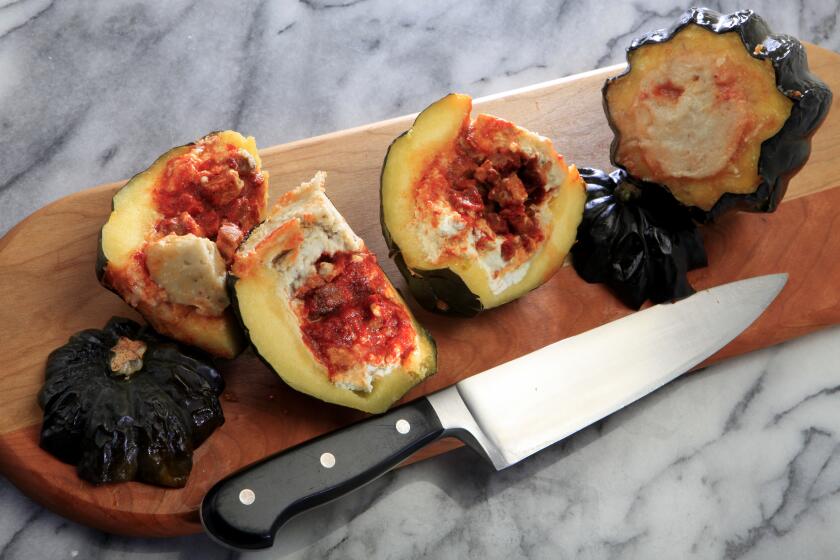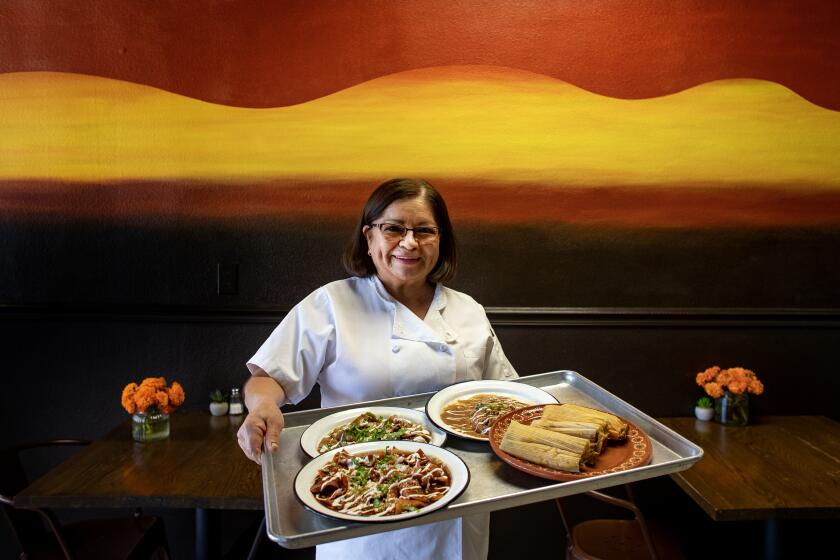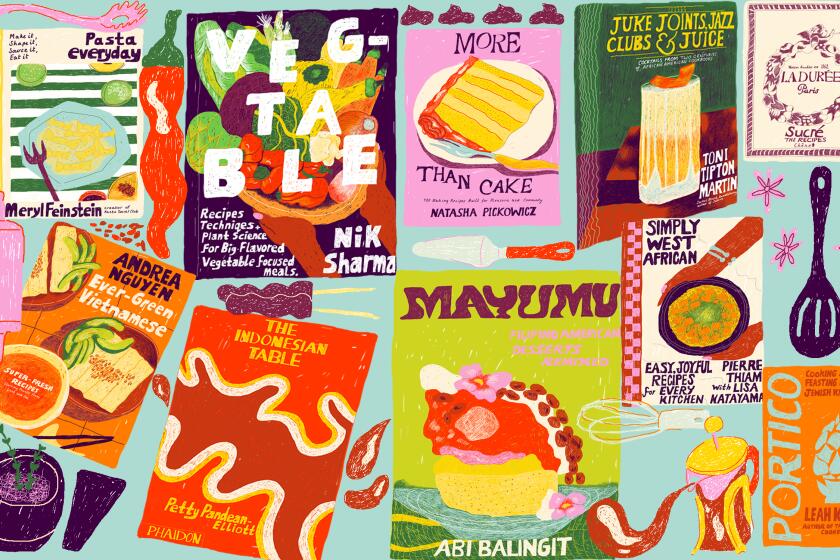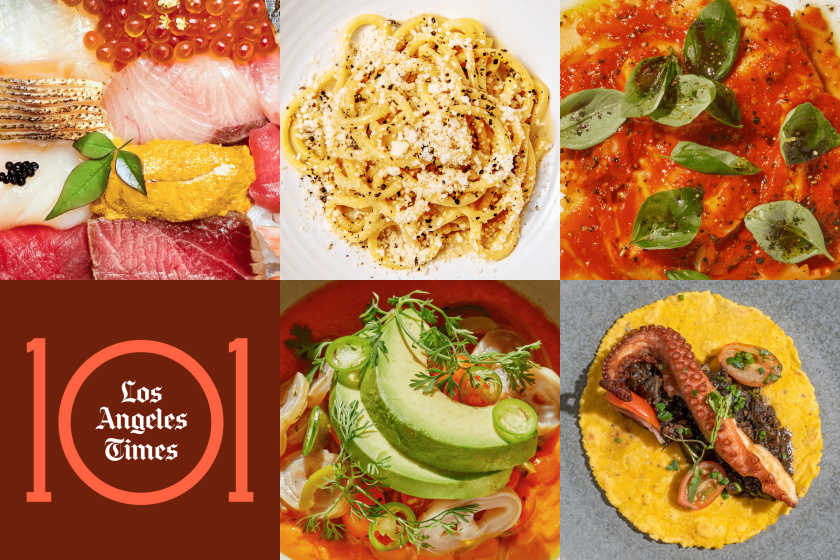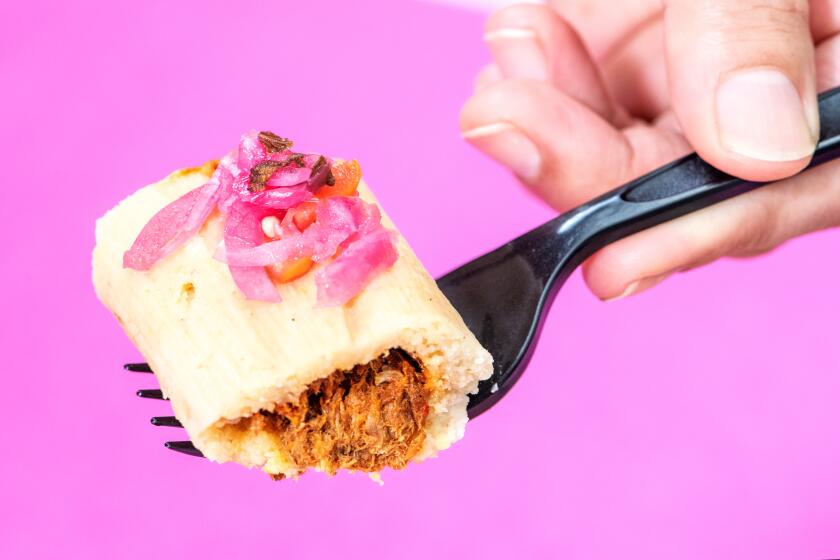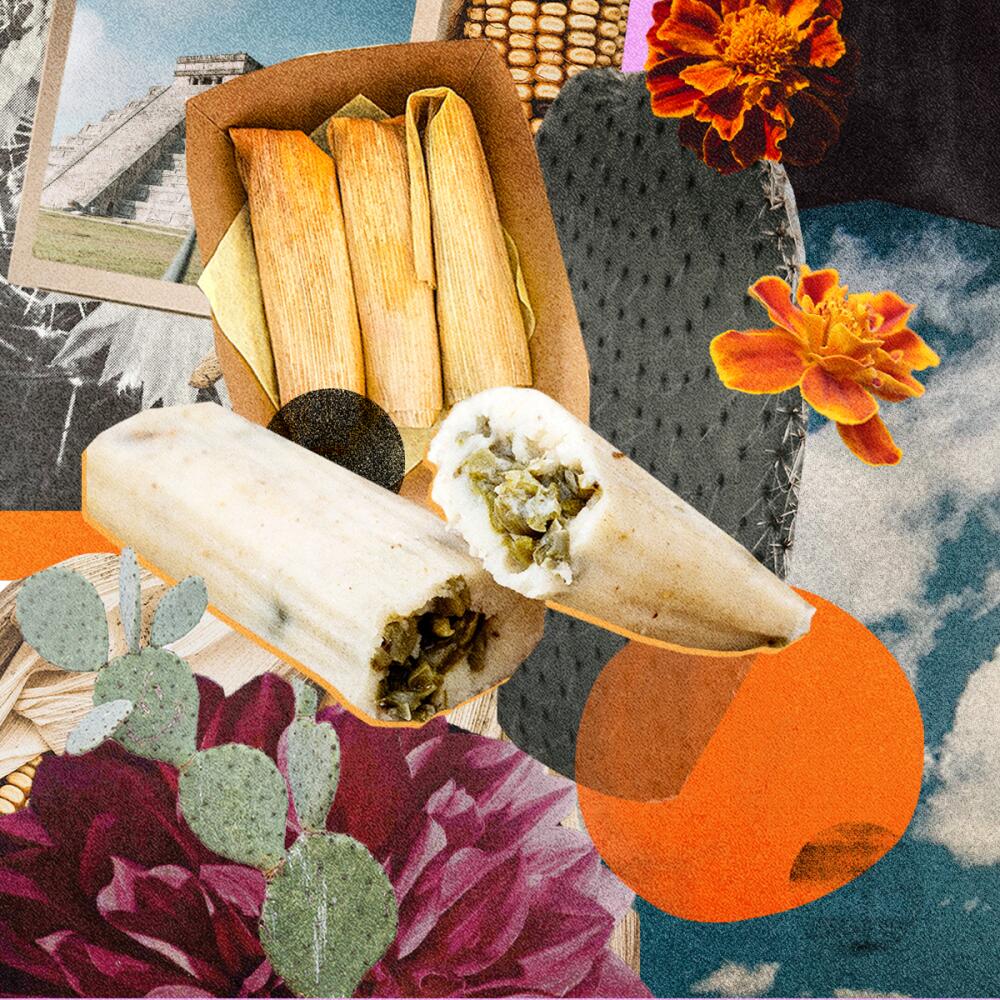
- Share via
Wrapped inside a fresh or dried corn husk is a soft maíz cake known intimately across the Americas as tamales.
A closer look beneath the husk reveals centuries of history beheld by generations of hands, known by many other names, and through a great plethora of recipes. From the Hopi blue corn tamales called someviki, and Venezuelan hallacas, to Brazil’s tender pamonha made with blended fresh corn, its variations spread far and wide.
Tamales tell the earliest stories of Latin American traditions and culture. Originating in Mesoamerica, this emblematic food first came to the table shortly after the inception of nixtamal in 1,000 BC — making it one of the first nixtamalized foods, along with atole.
Where can you find the world’s best tamales in Los Angeles? This list features essential places near you, just in time for Christmas and New Year’s.
In Mexico, around 500 variations of tamales exist — from handheld to 5 meters (16 feet) in length like the zacahuiles of San Luis Potosí.
And though they are found year-round in Mexico, tamales are most visible during traditional winter celebrations. In fact, “tradition” is perhaps the word most synonymous with an ancestral dish like the tamal.
Preserving historic recipes is critical work, particularly with recipes of Indigenous origin where colonialism has threatened its safekeeping.
But for modern-day chefs who are descendants of LatAm cuisine, room exists for traditional recipes to bend and crack, opening up possibilities for something new and reflective of today’s culture. Add migration to the modern mix, and chefs have access to not only different cultures but different ingredients, resulting in unusual and brilliant creations, often laced with critical messages.
For both traditional tamales and tamales with a twist, check out these recipes
Today, tamales breaking from tradition tell stories of queerness, first-generation American experiences, nostalgia and the future of Latine cuisine.
Chef and anthropologist Luna Vela from Austin, Texas, is the owner of Neighborhood Molino. Vela’s contribution to the canon of modern tamales is the hot dog tamal.
It started as a joke, Vela says.
“As a queer Mexican person who loves to make ancestral and regional dishes from Mexico, making a very white, American creation with my own touch, is a funny thought,” Vela wrote via email.
But once she began researching, she found it already existed. The hot dog tamal was a festival food known as the “TamArlington Dog” for the Texas Rangers.
From SoCal to the South, I discovered that the Delta’s hot tamales could be a bridge to the flavors of home.
“My version was made with my own nixtamalized heirloom corn masa, a nice 44-Angus Farms beef weenie, American cheese, the classic ketchup and mustard, paired with a nopal pico de gallo to incorporate some native ingredients from Texas,” Vela wrote. She says people’s reactions varied, from shock and anger, even ridicule. But overall, after a bite, people warmed up.
The history of the Texas Rangers police force isn’t lost on Vela. “[They] murdered and arrested countless Indigenous, Mexican and Black peoples in Texas for decades, erasing a lot of our native histories in these lands,” she said.
“I served this dish with a tiny Texas flag punctured in the tamal — it’s a statement, in a way,” Vela wrote. “It’s a food that sparks conversation, thought, discourse, and I find that is powerful within itself.”
For 30 years, the Indio International Tamale Festival has allowed entrepreneurs the chance to showcase their food. We visit three to hear their stories.
In El Sereno, Alex Garcia of Evil Cooks was originally inspired, like Vela, to make a hot dog tamal from a weenie wrapped in a tortilla.
While prepping tamales for an event, the idea came to Garcia and he asked his wife what she’d think of a hot dog tamal. He added onions, jalapeños and bacon to the masa dog creation, and thus their tamal de perro caliente was born.
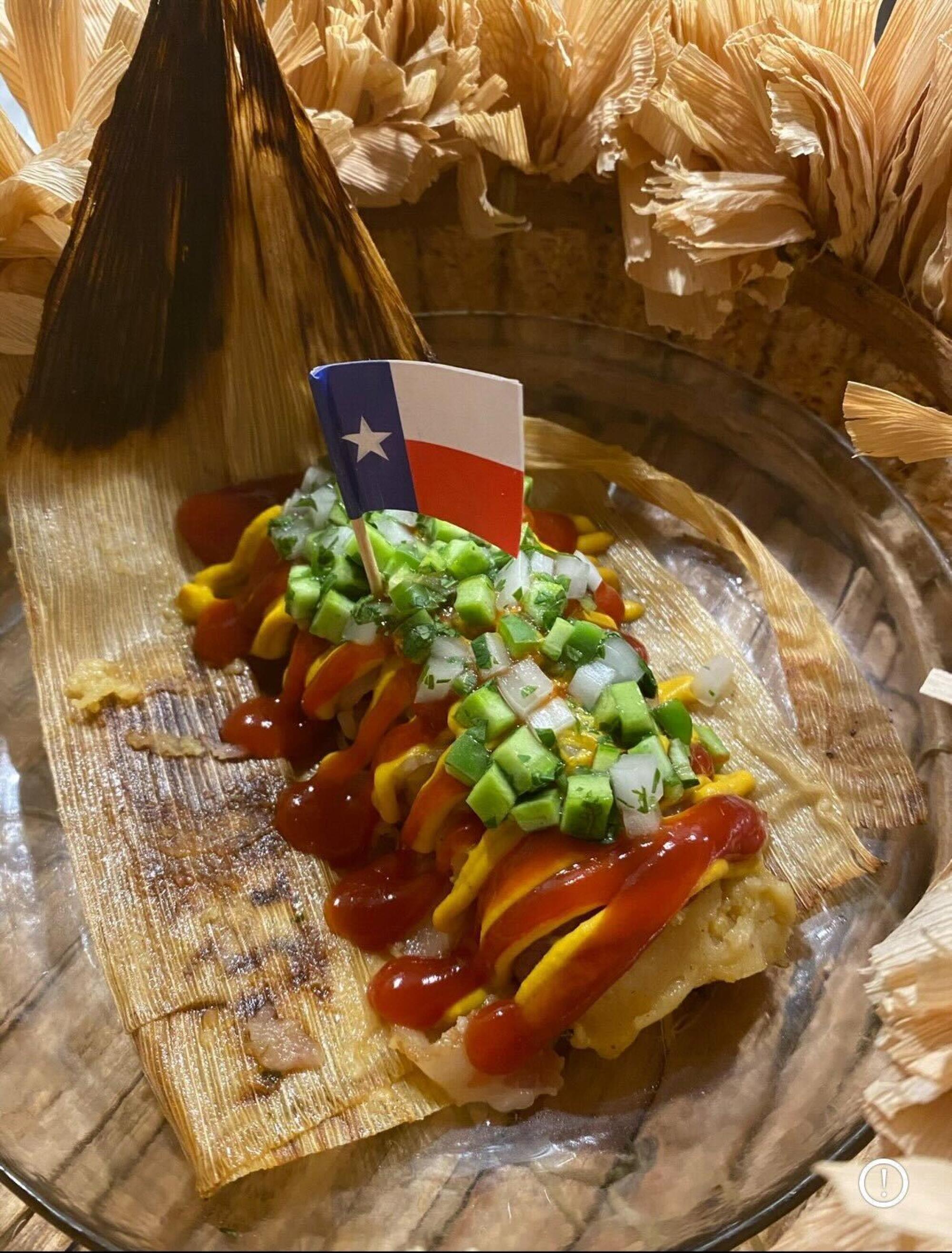
“People obviously sometimes hate these kinds of ‘experiments’ because you corrupt their minds and their memories [of] their parents and childhoods,” Garcia wrote via email.
There is a method to Garcia’s maddening creations, however.
Vintners and conservationists in Valle de Guadalupe are concerned that a tourism boom and water scarcity will lead to disaster.
“It is really important to think outside of the box because it’s the only way to have evolution, to find new flavors, and most importantly, have fun.”
For Tony Ortiz, Bay Area-bred and Brooklyn-based chef, his tamal series, “maíz mar—,” started as a way to “queer up the maiz and Mexican food scene,” he says.
“Mar—” is a derogatory word used in Mexico to refer to a gay man, but Ortiz wanted to reclaim the word as a way to create space.
“I was exploring ways that I could announce myself as a queer culinary artist within the big, scary New York food scene and I was like ‘What better way than to use the word mar—!’” Ortiz said. “The tamales held onto this old school, ancestral soul, but also brought forth a new queer energy in them.”
L.A. Times Food chooses the standout cookbooks of the year, from the best resources for baking, vegetarian cooking and pasta making to what to do with leftovers.
In Seattle, chef Janet Becerra, a first-generation Mexican American, makes a chocolate tamal at Pancita restaurant.
“We had just finished making rainier cherry jam with ancho reyes chile, ancho liquor and papalo ice cream,” Becerra wrote via email of her seasonally inspired tamal. Papalo is a grassy, astringent herb and ancho chile, the dried manifestation of the poblano chile, has plum-like notes.
“I thought the flavors would be beautifully highlighted on a chocolate tamal,” she wrote. “I am not trying to break any molds but rather highlight traditional techniques while using flavors that are familiar to me as a first gen Mexican American.”
Ana Castro, chef of Lengua Madre in New Orleans, first had her great-grandmother’s tamales, which were small and filled with her grandpa’s hunted deer meat, in Tamaulipas, Mexico.
If you’re searching for the essential food of L.A., let our critic’s 2023 restaurant list be your guide! Find the best vegetarian, Japanese, Mexican cuisine and more.
Today, at her bricks-and-mortar, which “reimagines” traditional Mexican cuisine, Castro makes a dessert tamal — the carrot cake tamal.
“Tamales are pure comfort,” she wrote in an email. “Carrot cake occupies that same spot for a lot of people, it’s easy, its cheap, it’s delicious!”
Castro says she got “cheffy” with the creation, making their own pecan miso, and using local cane syrup, tonka beans and cheese from a local cheesemonger called Le Cyprien.
“People loved it!” Castro writes about the tamal’s reception. “It’s key that we make traditions our own to preserve them. The world is in constant change ... it is only natural that Mexican cooking evolves along with how the meaning and sentiment of being Mexican is always in constant flux.”
Critic Patricia Escárcega answers a reader’s question: Who is allowed to make tamales?
For Estefania Trujillo Preciado, chef and educator located in Cali, Colombia, her neo-traditional tamal was inspired by a breakfast dish whipped up by her grandparents, “an Afro Colombian Pacific dish called Tapao de Pescado, with smoked fish or tollo (shark), and a side of plantains or cassava,” Preciado wrote in an email.
Her family was receptive to her tamales that hold together a generational food memory wrapped in plantain leaves.
For Preciado, it reiterated her belief that food memories replicated outside of their traditional contexts in a reimagined manner are extremely valuable to the culinary fabric of diasporic food.
“We are somewhere else now, with different ingredients and people around us, and trying to replicate that perfect memory is impossible,” she wrote. “When we try to match the love and intention of that moment instead, we surprise ourselves with the memories that get unlocked, and new ones that get made.”
Andrea Aliseda is a food and culture writer, vegan recipe developer and dog mom based in Brooklyn, N.Y., with published work in Harper’s Bazaar, Bon Appétit and Epicurious. She’s currently working on her debut plant-based Mexican cookbook, and you can find her on Instagram at @andrea__aliseda.
More to Read
The Latinx experience chronicled
Get the Latinx Files newsletter for stories that capture the multitudes within our communities.
You may occasionally receive promotional content from the Los Angeles Times.

